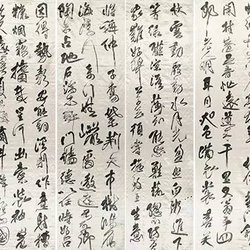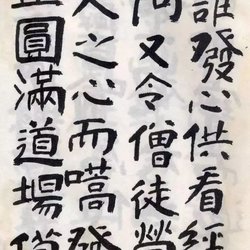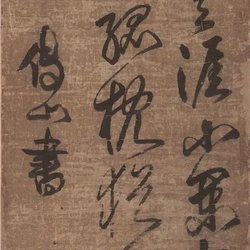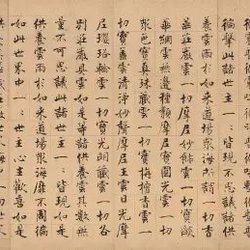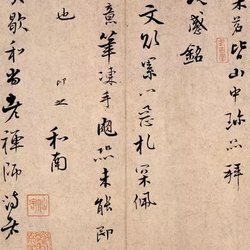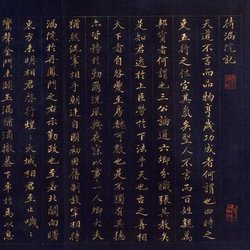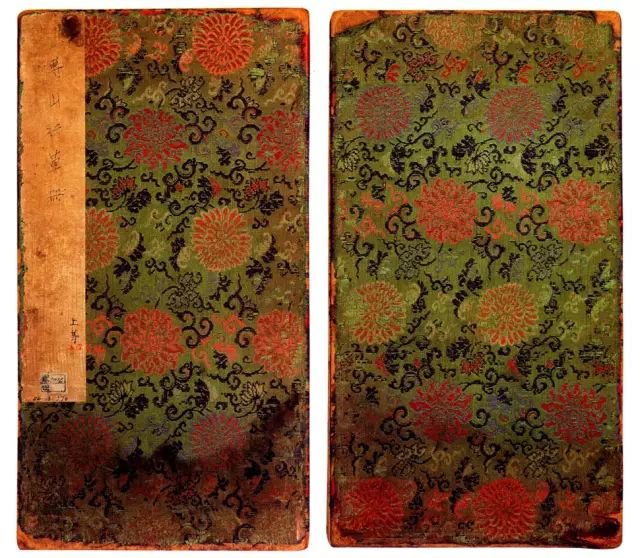
Fu Shan's "Various Style Books"
Paper 29cm×15cm×2×12 Collection of Shanxi Provincial Museum
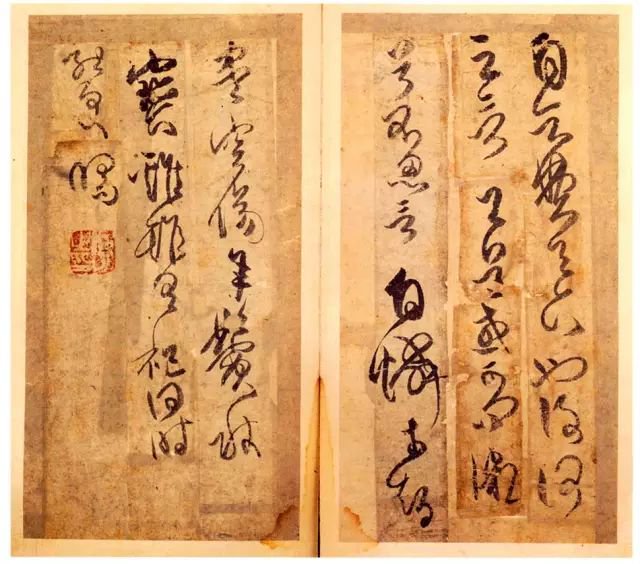
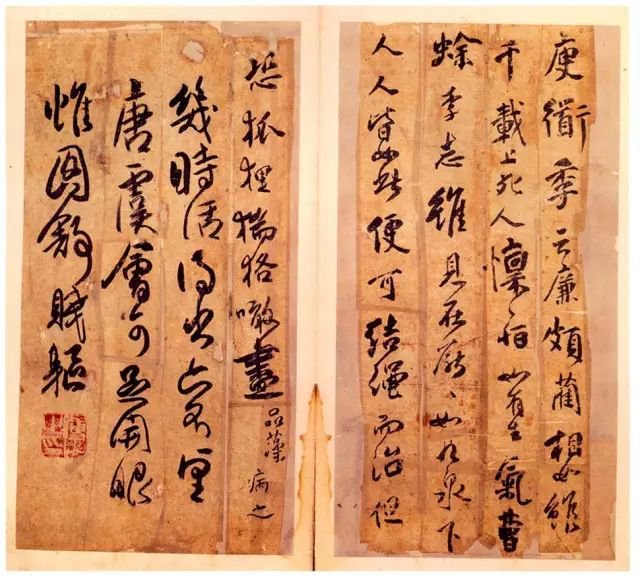
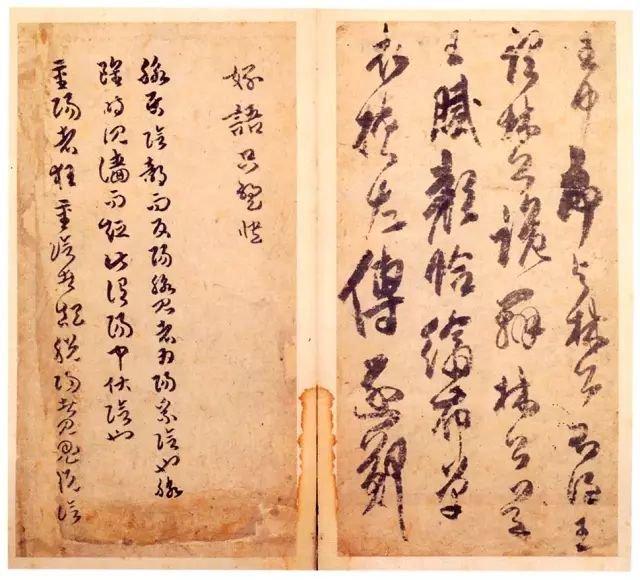
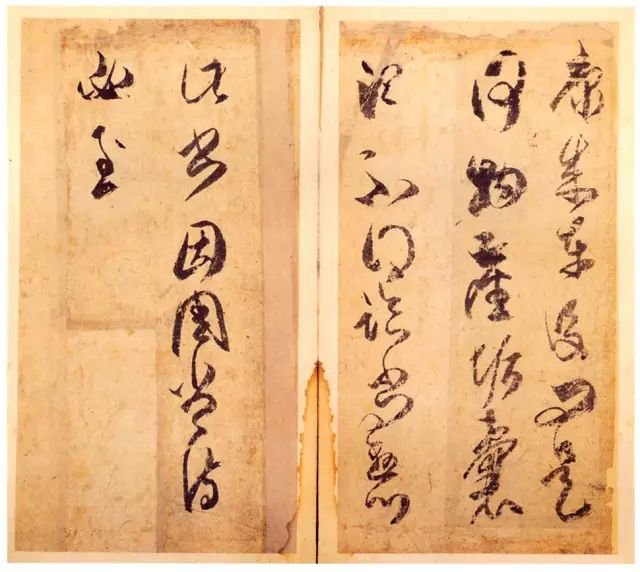
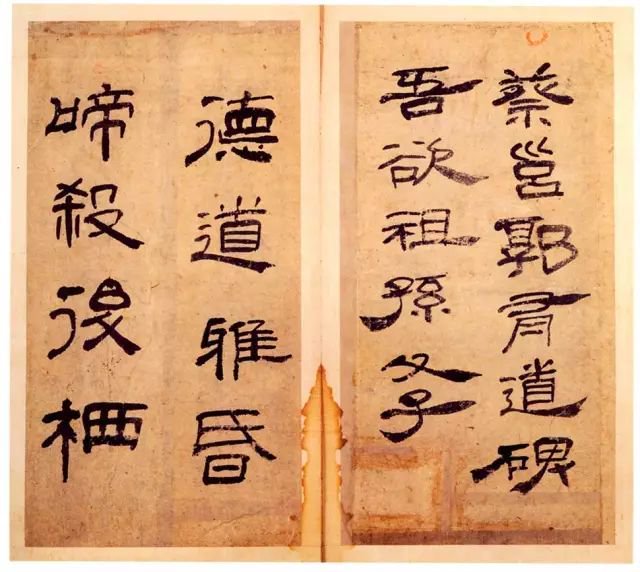
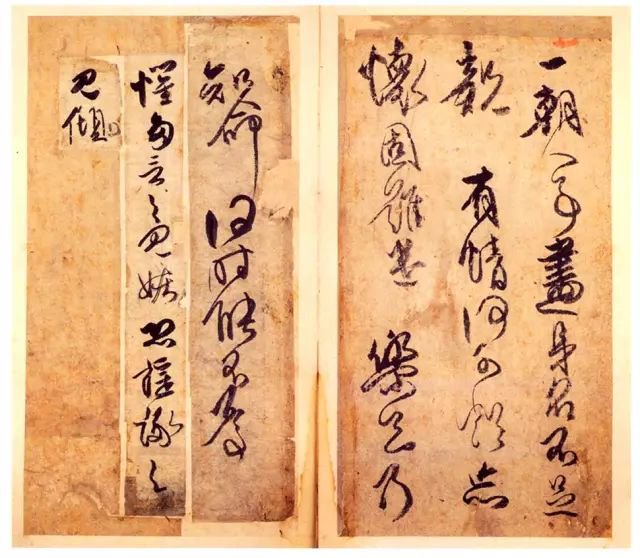
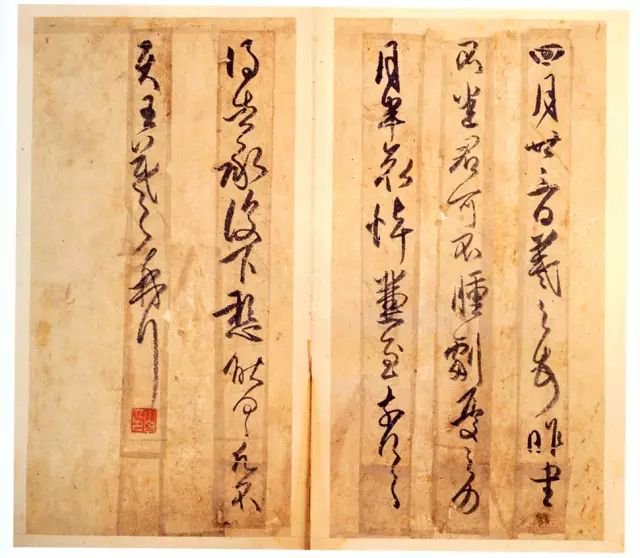
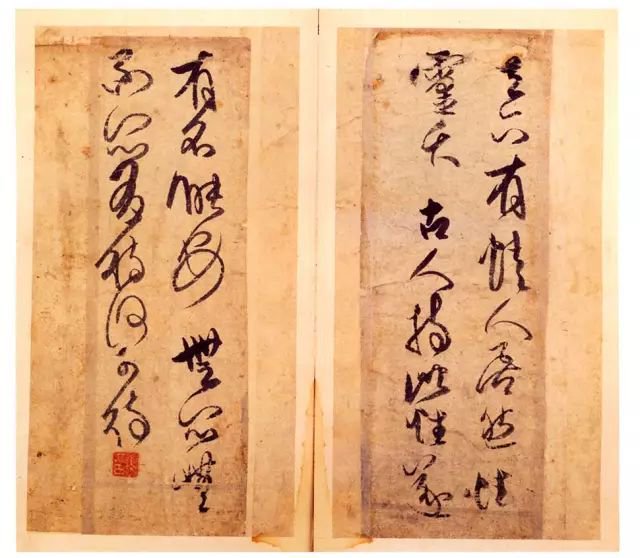
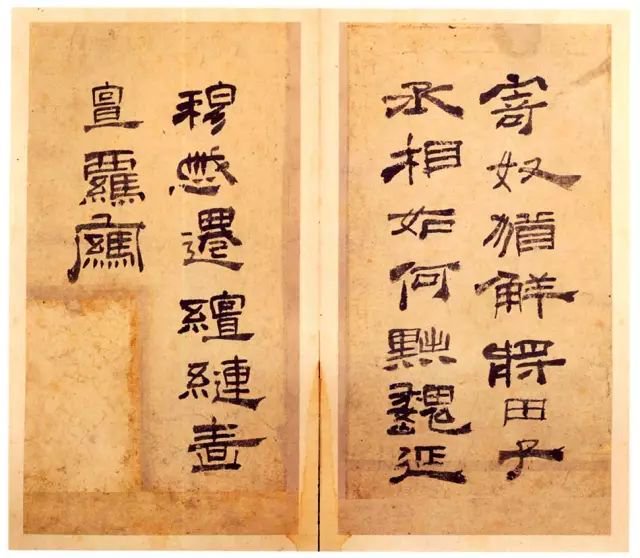
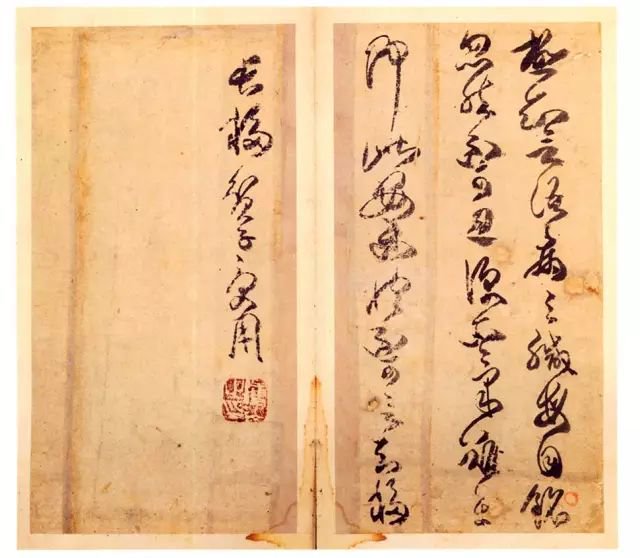
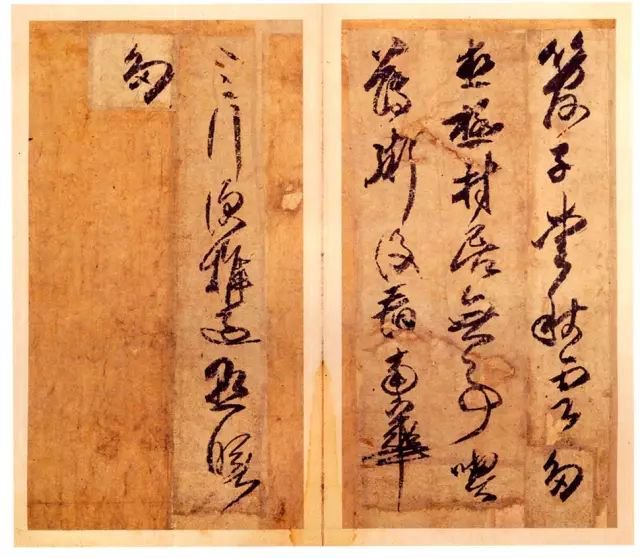
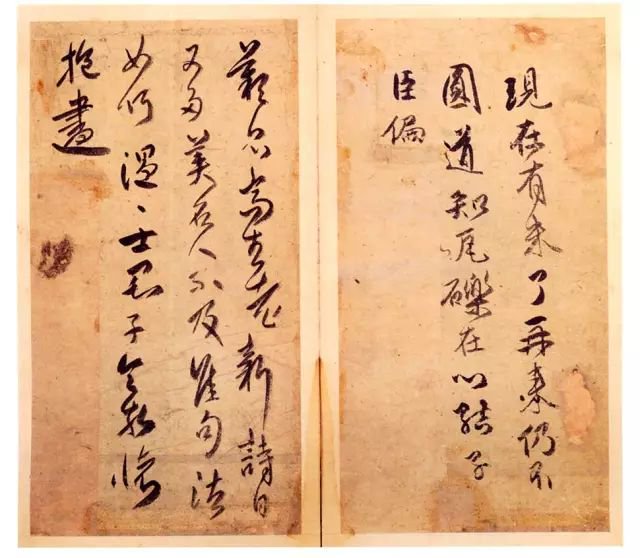
Fu Shan (1607-1684 or 1685) was born in a family that has been scholarly for generations. He received a good private school education since childhood, and calligraphy, as a basic education link, also received strict and systematic training. In his later years, Fu Shan recalled that he started learning calligraphy at the age of eight or nine, and continued to practice calligraphy when he was seventy-seven. The calligraphy activity accompanied Fu Shan for nearly seventy years and influenced every change in Fu Shan's calligraphy style. It is impossible to accurately count the posts that Fu Shan wrote. According to the records in his collected works, calligraphies and handed down works, Fu Shan visited hundreds of schools of thought, involving Zhen, Cao, Li, Zhuan and Xing, and exerted influence on them. The main influential ones were Zhao Mengfu, Yan Zhenqing, Zhuan Li and the two kings. This article attempts to sort out the characteristics of Fu Shan's writings in various periods and explain the influence of writings on the formation of his calligraphy style.
"Pindao is about twenty years old. He has mastered the regular calligraphy of Jin and Tang Dynasties that was passed down from his ancestors. Occasionally I came across Zhao Ziang's Xiangshan poems written in ink, and I loved the roundness and smoothness of it, so when I read it, I didn't count the poems and wanted to misinterpret them. "When the young Fu Shan was struggling with his calligraphy skills, he met Zhao Mengfu. Because he "loved his roundness and fluentness", he worked hard to improve his calligraphy skills. Enter. Zhao Ziang's calligraphy was very suitable for Fu Shan's taste. In the following ten years, Zhao Mengfu became Fu Shan's main calligraphy study target until after the Jiashending Revolution. Although we can't see Fu Shanlin's works about Zhao Mengfu now, judging from his early works "Jia Xing De's Red Letter Poetry Manuscript" and the stone rubbings "Shanglan Wulong Temple Garden Notes", it is clear that Zhao Mengfu's smooth and beautiful flavor is revealed . We can also find the shadow of Zhao Mengfu in Fu Shan's other small running script works, and this influence is still reflected in Fu Shan's late works, such as "Lin Tie Album" collected by Shanxi Museum and "Lin Wang Xizhi" collected by Jinci Museum. The legacy of Zhao Mengfu can be seen in the second half of the hand scroll written by Zhang Ling and others. It can be seen that when Fu Shan was young, he put a lot of effort into Zhao Mengfu's calligraphy, so that his future works would inadvertently bring out the flavor of Zhao's calligraphy. No wonder Fu Shan in his later years often lamented: "But my skills are mixed" and "When I was a boy, I was bad at paper and pen, but I was bad at writing." 』
When he was young, Fu Shan was immersed in Zhao Mengfu's calligraphy. First, he was influenced by the calligraphy style at that time. Since the Ming Dynasty, Zhao Mengfu's calligraphy has been popular in the calligraphy world. Dong Qichang, who was the leader in the calligraphy world in the late Ming Dynasty, even called Zhao Mengfu one of the "five calligraphers". "Nothing has happened in a hundred years", making Zhao Mengfu the first person after Wang Xi. The young and somewhat ignorant Fu Shan will inevitably be affected by this trend; secondly, before Fu Shan studied Zhao Mengfu, he was exposed to stone carvings from the Jin and Tang Dynasties, so his spirit cannot be "short of". When Zhao Mengfu was making ink, he was immediately attracted by his "round and fluent" style. It was natural to like and get started with it. Thirdly, Zhao Shu's "moisturizing and round style is still in the right vein". It has been slightly changed since "Lanting". "Zhao Shu is the one who cares about Wang Youjun." Fu Shan knew that Wang Xizhi's calligraphy was in the right vein, but since he couldn't see the ink marks, he had to settle for the next best thing.
After Jiashen, Fu Shan's attitude towards Zhao Mengfu changed drastically: "Yu Ji didn't like Zhao Zi'ang, he treated him poorly, and therefore disliked his writings." ” “Being charming and graceful is naturally a mean attitude. "I hate that his books are shallow and vulgar, just like King Xu Yan's boneless ones." "Obviously, Fu Shan denounced Zhao Mengfu because of political reasons and character issues. As the saying goes, deep love means deep pain. But as far as the art of calligraphy itself is concerned, Fu Shan is convinced that Zhao Mengfu "can't be blamed".

The scroll of "Cursive Script Lin Tie", collected by the Palace Museum in Beijing, is on damask, 162.2cm long and 44cm wide.

Fu Shan's "Scroll of Jiangzhou Posted by King Lin", silk edition, 174.5x50.5cm, collected by the Palace Museum, Beijing
Fu Shan Linyan Zhenqing
Influenced by his family education, Fu Shan studied Yan Zhenqing since he was a child, but he really devoted himself to studying after Jiashen. Bai Qianshen deduced that his enthusiasm for Yan Zhenqing's calligraphy style began in the late 1640s and 1650s. According to Fu Shan's own narrative, he had carefully studied "Family Temple", "Magu", "Ode to the Zhongxing of the Tang Dynasty" in Yan-style regular script, and "Fighting for Seats" and "Manuscript for Nephew Memorials" in running script. Fu Shan has a work called "Linyan Zhenqing Magu Immortal Altar" written in the 1650s. In addition to the thick lines, the overall style is basically a copy of Wang Xizhi's small regular script and the characteristics of the characters. There is no trace of the original stele at all. Broad and sincere. There are probably two possibilities for this: one is that Fu Shan is doing a deliberate exploration, that is, using Wang Xizhi's brushwork that he is accustomed to, copying Yan Zhenqing's small regular script, trying to find a point of convergence between the two; the other is that Fu Shan has been trained in Wang Xizhi's system of small regular script since he was a child. , has formed a relatively stable style. After Jiashen, he changed to Yanti lower regular script, but he could not get rid of Wang Xizhi's influence in a short period of time. Therefore, in Linyan Zhenqing's "Magu Xian Tan Ji", he intentionally or unintentionally brought out the flavor of Wang Xizhi's lower regular script. . Another album of "Zhuangzi Xiaoyaoyou" written in small regular script in 1653, although there are still shadows of Zhong Yao and Wang Xizhi, the more obvious expression is the condensation and thickness of the pen, the smooth and broad strokes of the characters, the authentic Face and body style. In large-character regular scripts, such as the couplets "Xing Ding Shen Xian" and "Bamboo Rain Tea Smoke" stored in the Jinci Museum, they show a more direct and pure style of facial expression.
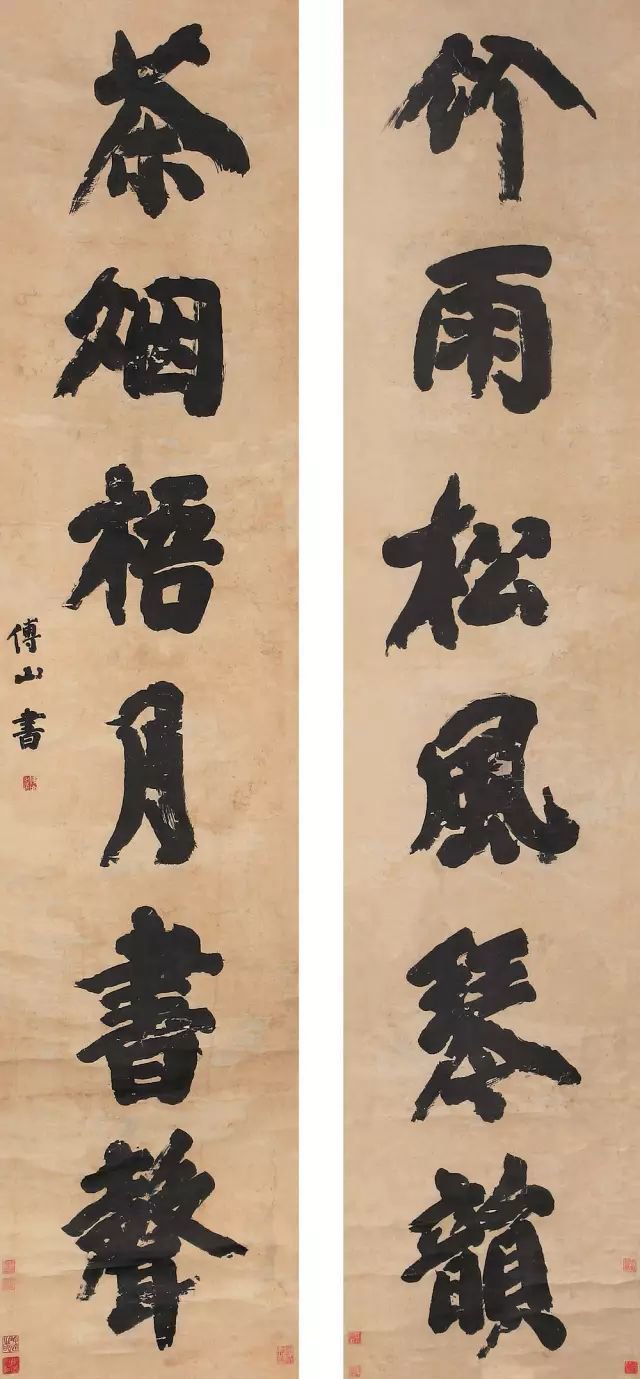
Fu Shan's "Bamboo, Rain, Tea and Smoke Couplets" scroll, paper, 225×44cm×2, collected by Shanxi Jinci Museum
In terms of running script, in Fu Shan’s calligraphy from the 1640s to the mid-to-early 1650s, we find inconsistencies and instability in his calligraphy style. This is why Fu Shan learned Yan style running script and changed his original appearance. Performance in the exploration phase. By the mid-to-late 1650s, Fu Shan's running script style with Yan Zhenqing as the main tone was basically formed, which was also the representative style of Fu Shan's small running script. Regarding Fu Shan's representative work "Danfeng Pavilion" written in 1660, Mr. Lin Peng said: "It is completely authentic to the Yan style, and the brushwork structure is straight after Pingyuan." The "Zuo Jin" album, written in the 1660s, is very similar to Yan Zhenqing's "Manuscript for Memorials to My Nephew" in terms of writing style, knotting and overall style. Fu Shan has completely integrated the characteristics of Yan's running script into his own style middle. For Fu Shan, who was aloof and full of personality, being able to follow Yan Zhenqing's footsteps and learn to copy it can only show that Yan Zhenqing deeply attracted him both in terms of personality and calligraphy skills.

Fu Shan's ancient scroll with walking grass
The serious study of Yan Zhenqing after middle age was the most important stage of Fu Shan's calligraphy learning in his life. Later calligraphy, whether it was regular script, running script or continuous cursive, was dominated by Yan style. Fu Shan chose Yan Zhenqing as a model for his lifelong study, probably for the following reasons:
One is the origin of family education. Fu Shan later said in "Written as a Character for Children and Grandsons": "It is the Duke of Lu who was learned by the ancestors of the Fourth and Fifth Generations of Fu Shi Zong." ’ It is also said: ‘The calligraphy of the seniors in Jinzhong all excelled in their strength, so they came close to Lu Gong, but many did not pass it on. In Taiyuan, my family is the only one who has practiced this skill from generation to generation. ” This shows that Fu Shan’s ancestors have been studying Yan Zhenqing, and regard learning Yan as the only way for the children of the Fu family to learn calligraphy. The thick, majestic and majestic style of Yan calligraphy is very in line with the aesthetic psychology of northerners, and is more in line with the upright and heroic Fu Shan. Fu Shan should have received good training in Yan style calligraphy since he was a child, and he was very affectionate towards Yan Zhenqing and his calligraphy.
The second is political reasons. This is the most direct reason why Fu Shan did not hesitate to choose Yan Zhenqing's calligraphy after he reached middle age. Fu Shan was educated in Confucianism since he was a child. He is a person with a strong sense of social responsibility and historical mission. When faced with the historical experience of sudden changes in mountains and rivers, and the destruction of his family and country, Fu Shan chose to resist and not cooperate. In the end, he chose to use literary and artistic means as a political and ideological weapon. Yan Zhenqing, who is fearless and loyal in the face of danger, is undoubtedly the best example for Fu Shan to learn from. In his later years, Fu Shan had two notes describing why he studied Yan Zhenqing's calligraphy so seriously:
"I often visit the two kings. I wrote to Xizhi and Xianzhi for thousands of times, but I didn't take it seriously." But when I wrote the name of Lord Lu, I couldn't help feeling awe-inspiring. I don't know why? I still read the Chronicles of the Three Kingdoms, and when it comes to Guan and Zhang affairs, I unconsciously tend to be in Zheli. 』
"Only those who dare to look sideways at Duke Lu's post are shown." The conscience of the ministers. 』
Fu Shan wrote in "Writing Words to Show Children and Grandsons":
"The first thing to write is to write a person, and people have wonderful words since ancient times." The outline often rebels against Zhou Kong, and the pen and ink cannot make up for it. Sincerity has a certain point of view, but the writing power is not expert. Add five fingers to one arm, and you can see the six lines of Qian Gua. Whoever uses the nine has his heart and wrist. Yongzhen traces Xiwen, but Liu Gongyu is not easy to write. Before studying Lu Gong's writings, first read Lu Gong's exegesis. The Qi of the plains is in the air, and the feathers are enough to swallow the captives. 』
This poem, written for children and grandchildren, to educate future generations, proposes that Yan Zhenqing is a model of life and writing. He warned his descendants that only a person as high-minded and upright as Yan Lugong could write such powerful and powerful calligraphy. Only such powerful and heroic calligraphy could use pen instead of sword to realize one's life ambitions. Mr. Wei Junxiu believes: "(This poem) specifically mentions Lu Gong, who has been passed down by people and letters. His attitude is serious and his momentum is majestic. He thinks of future generations. It has far-reaching implications and is of great significance." It is a programmatic poem in Fu Shan's calligraphy theory. "Fu Shan obviously possesses the dual qualities of Yan Zhenqing, so he found a compatibility point from Yan Zhenqing's calligraphy aesthetic paradigm.
3. The origin of calligraphy. What attracted Fu Shan was not only Yan Zhenqing's loyal image, but also the characteristics of Yan Zhenqing's calligraphy style. In "Xun Zi Tie", after comparing the calligraphy characteristics of Zhao Mengfu and Yan Zhenqing, Fu Shan put forward the famous point of view "It is better to be clumsy than clever, ugly than charming, detached rather than slippery, and straightforward than arranged." Fu Shan believes that Yan Zhenqing's calligraphy represents clumsiness, ugliness, fragmentation, and straightforwardness, while Zhao Mengfu's calligraphy embodies skill, charm, smoothness, and arrangement. The Yan style calligraphy has the correct seal style and is unpretentious; in addition to the graceful and tranquil traditional calligraphy style of "Two Kings", it has raised another flag of roughness and boldness, which is regarded as "ugly"; the knots are loose on the inside and tight on the outside, and the turning points It is lively and smooth, which can be described as fragmented; the pen is free and natural, and expresses the heart directly, which can be described as straightforward. "Clumsy, ugly, fragmented, and straightforward" are also the main aspects that Fu Shan adopted from Yan Zhenqing. These characteristics were eventually integrated into Fu Shan's other calligraphy styles, especially in his continuous grass. Yan Zhenqing is not only a model that Fu Shan admires, but also the perfect embodiment of his "Four Nings and Four Don's" calligraphy theory, and is the main source of Fu Shan's calligraphy.
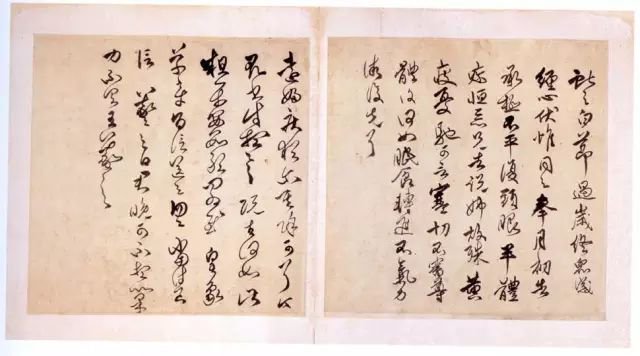
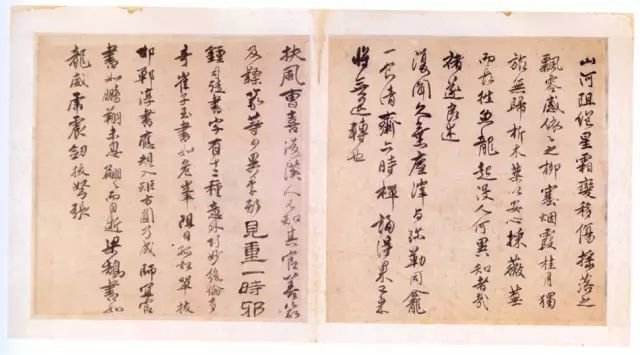
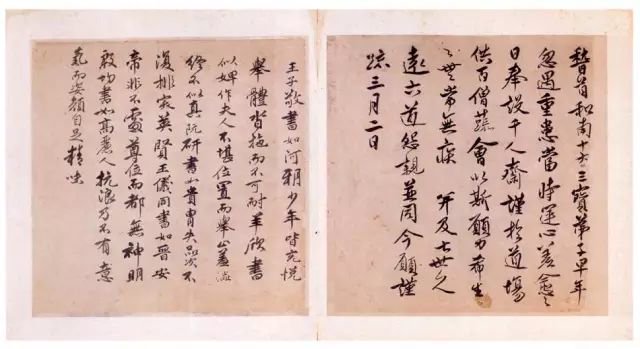
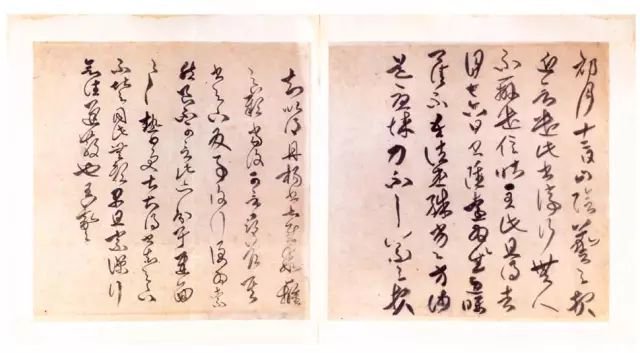
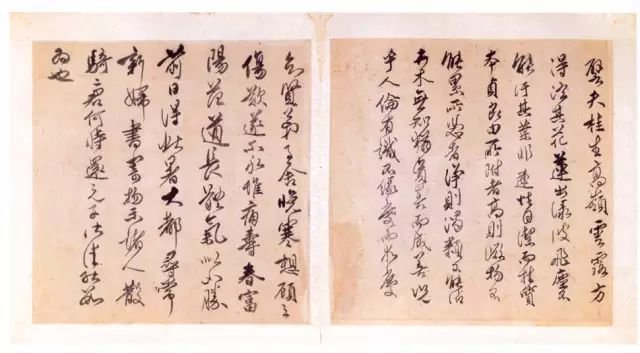
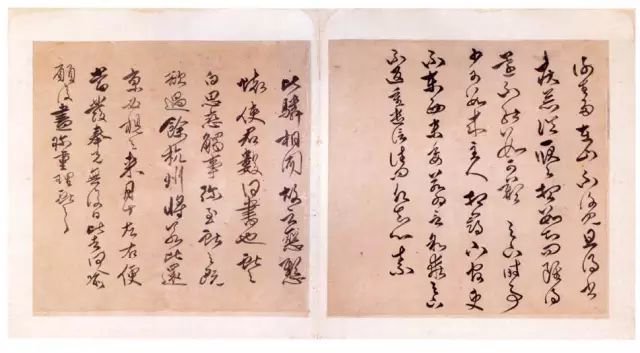
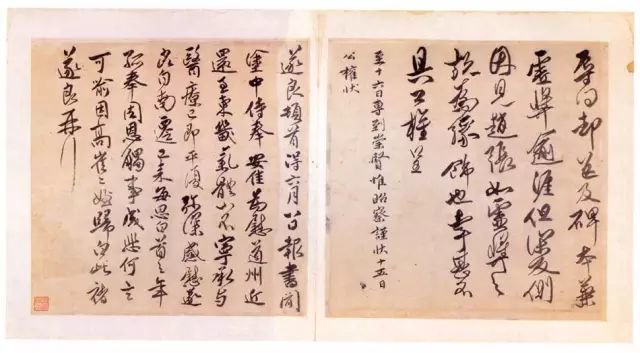
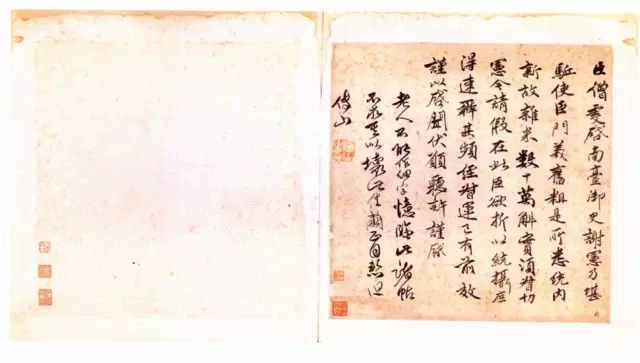
Fu Shan's "Album of Cursive Calligraphy", paper, 32cm×32cm×2×8, collected by Shanxi Provincial Museum
Fu Shanlinzhuanli
After middle age, Fu Shan began to pay attention to seal script and official script, and put forward many powerful, clear and powerful views:
"I don't know how to make seal scripts, but I've been sleeping hard on teaching calligraphy and learning calligraphy." 』
"If you don't write seal script and official script, even if you study calligraphy for thirty-six thousand days, you will never get to where you are. You will never know where you are." 』
"Regular script does not come from seal script, official script, and bafeng script, so it is in a servile state and is not worth observing." 』
"Regular script doesn't know the changes in seal script and official script. No matter how wonderful it is, it will end up being a common style." The unpredictable aspects of King Zhong all come from Adu. 』
"As for the Han Li method,...the beauty is that people don't realize how ugly and simple this method is. 』
Fu Shan also put this theory into calligraphy practice. The seal script and official inscriptions written after middle age include "Shigu", "Yishan", "Zhang Qian", "Shi Chen", "Huashan", "Liang Hu", "Cao Quan", "Xia Cheng", " "Kong Zhou", "Yin Zhou", "Heng Fang", "Yi Ying", etc. Some of the steles were even copied over and over again, showing many insights. Fu Shan has handed down many seal script works, but the quality is not high and cannot be compared with other calligraphy styles. His purpose in learning seal script and official script was to use it, take the richness, simplicity, and fragmentation of seal script and official script and integrate them into other calligraphy styles, especially cursive script, and finally create a unique continuous grass. In Fu Shan's "Lin Caoquan Stele", we can see that he weakened the regular and graceful characteristics of the original stele. The lines were rough and the structure was odd and sideways, which was far from the original model. It was obviously based on grasping the rough glyphs. "Immediately". Through this work, we seem to be able to see Fu Shan's attitude and method of learning seal script.
The reason why Fu Shan attaches so much importance to seal script and official script is: First of all, in the early Qing Dynasty, academic tracing, the revival of epigraphy, and the active activity of visiting monuments promoted changes in aesthetic trends. In calligraphy, learning seal script and official script was also regarded as an artistic innovation. secondly, after Jiashen, Fu Shan began to copy Yan Zhenqing comprehensively and enthusiastically. A very important feature of Yan's calligraphy is that it is ancient, simple, and has the charm of seal script, and the characteristics of seal and official script are in line with Fu Shan's "Sining" The aesthetics of "Four Don'ts". Fu Shan was inspired by Yan style calligraphy, found inspiration, and learned how to integrate seal script and official script into cursive script. Fu Shan's ideas and practices in seal script not only made his calligraphy art possible, but also initiated the germination of the idea of stele studies in the early Qing Dynasty.
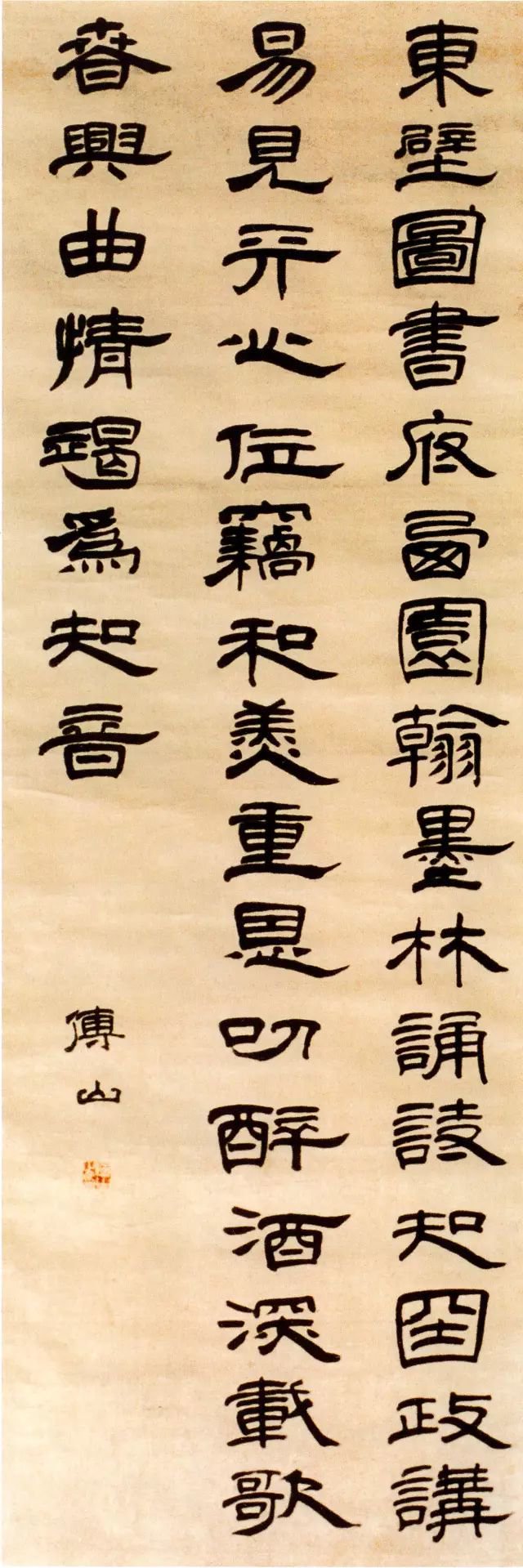
Fu Shan's "Five-Character Poem Scroll of Official Script Zhang Shuo Enzhi Granting Food" on silk, 143x48cm, collected by Shanxi Jinci Museum
Fu Shanlin and the Second King
When Fu Shan recalled his study history in his later years, he said:
"I came to Yuanchang when I was eight or nine years old. It's not like that." Shao Chang, such as "Huang Ting", "Cao E", "Le Yi Lun", "Dongfang Pian", "Thirteen Lines of Luo Shen", and "Ba Xie Lun", are all present, and none of them are similar. Finally, I wrote Lu Gong's "Family Temple" and got a few details of it. Going back to "Strive to Sitting", it seems like breaking the desire. Then he came to "Lanting". Although he couldn't understand its expression, he gradually wanted to know the outline of this technique. 』
He also said: "I have written "Huang Ting" thousands of times. 』
Fu Shan received strict training in the "Two Kings" system of Dharma writing since childhood. Due to the needs of his career, he mainly used regular script. A large number of his works in small regular script handed down from generation to generation have the basic style of "Er Wang", which shows that Fu Shan worked hard on "Er Wang" small regular script in his early years. The rigorous training at SNSD not only laid solid basic skills, but also planted a sacred seed in Fu Shan's young mind. After experiencing ups and downs in life, Fu Shan began to reflect calmly in his later years. He studied the pre-Qin scholars in depth, hoping to find the root causes of social crises and changes in ownership of mountains and rivers from orthodox Confucianism and the traditional political system. In calligraphy, he began to pay more attention to the "Two Kings" and believed that the "Two Kings", especially Wang Xizhi, were the "Mahayana" of calligraphy and a traditional classic. From his understanding of the "Two Kings", he "gradually wanted to know the basics of this technique." At this time, Fu Shan had a great enlightenment.

Fu Shan's scroll of "Zhu Cong Tie" written in cursive script by Wang Xizhi, paper, 186.5cm×40.5cm, collected by Shanxi Provincial Museum
Fu Shan's return to "Two Kings" is first reflected in his emphasis on and study of "Lanting". Mr. Lin Peng said that Fu Shan had seen at least three versions of "Lanting" ink marks. Various versions have been carefully studied. There are two copies of Fu Shanlin's "Lanting Preface" handed down from generation to generation: one on silk and one on paper. According to expert research, the silk version was written according to "Dingwu Ben". There is a title later:
"The Story of Orchid Pavilion" is plain and straightforward, always advocating sighs and elegance. The people of Jin Dynasty are high-minded, and they never get tired of repeating their stories three times, and their true recovery makes people feel deeply sad about the past and present. It is ridiculous for common people to presume that there is a clear reason for not choosing...
The other is a paper version, produced in the "Chu Facsimile" in 1677, when Fu Shan was seventy-one years old. There is also an inscription:
Xiang saw the "Lanting" written by Fu Dingwu in Xing Taifu's family. It was all about neat and tidy markings. Compared with the "Lanting" written by others today, it is quite inferior. Compared with the original version of Tang Lin, it is quite different. ... Chu Lin is already here, and he doesn't know what he can do about the restoration of the right army's original work.
From the above two inscriptions, it can be seen that Fu Shan highly praised the "Lanting Preface", especially the authentic "Chu Facsimile", and even worshiped the authentic "Lanting Preface" that was buried in the grave, and was somewhat fascinated. "Simple and straightforward", "Elegance and love are words that make people of Jin Dynasty noble and never tire of it again and again" are Fu Shan's personal experiences after studying seriously. In a letter to a friend, Fu Shan said this:
If you can send me two copies of "Lanting", how about having a copy? I have seen several kinds in my life, but only Henan Linben is a true treasure and cannot be obtained. Of these two types, if so, you should not underestimate them.
"Don't look down on others." Does Fu Shan think "Lanting" is too precious to avoid damage? Or maybe Fu Shan has some selfish motives and is afraid that others will learn from him secretly? Food for thought. But one thing is certain, Fu Shan regarded "Lanting" as a treasure and never tired of it.
We noticed from the two works of "Fu Shan's Linlan Pavilion Preface" that the written works basically followed the font and composition of the original model, and even the missing words and corrections in the model were copied faithfully. This shows Fu Shan's admiration for Wang Xizhi. and devotion to "Orchid Pavilion".

Fu Shan's "Cursive Script Lin Wang Xizhi's Mingfu Tie" scroll, silk, 191cm×49cm, collected by Shanxi Provincial Museum
Fu Shan's study of "Two Kings", in addition to "Lanting Preface", mainly included "Ge Tie". Among Fu Shan's handed down works, most of them are his dharma calligraphy to the "Two Kings" in his later years, such as "Qiu Ling Tie", "Fu Xiang Qing He Tie", "Ming Fu Tie", "Champion Ermei Tie", "Anhe Tie" ", "Anxi Shu Tie", "Lun Deng Tie", "Xuan Du Tie", "Shu Chou Tie", "Zhu Cong Tie", "Zhu Huai Tie", "Twelfth Day of the First Month Tie", "Dewan Tie" "Shu Tie", "Seventeen Tie", "Jiangzhou Tie", "Kuozhuan Tie", "Fujun Tie", "Shide Tie", "Xiaoyuan Tie", "Zhang Ling Tie", "Zhiyudong Tie" "Post", "Extremely Hot Post", "August Post", "Missing Brother Post", etc. Some of them were written several times. These temporary works have the following characteristics:
1. Most of Daxi's works are for social occasions. Most of Fu Shan's handed down works are large scroll works. In terms of quality, they are generally not very high. The content is pieced together arbitrarily, the writing is frivolous, the composition is random, many details are not in place, and the writing is quite sloppy. It is obviously not Fu Shan's works. Works "for use" or "for self-entertainment"; judging from the materials, most of these large-scale scroll works are on silk and damask. In his later years, Fu Shan basically lived in the mountains and lived a life of poverty. He often needed help from friends in life. It was unlikely that he would use expensive silk and damask to practice calligraphy. The calligraphers should have prepared the materials in advance and came to Fu Shan to write. of. Why did Fu Shan regard a large number of temporary works as entertainment works? There is a passage that finds the answer for us:
When people ask me for a letter, they often say that I don't want to write poetry, but just write a post. Tie is a ready-made calligraphy written by the ancients. It is not taboo and is used by everyone. Poetry arouses suspicion and offends many people. The pen and inkstone are also feared.
Among Fu Shan's large scroll paintings, there are also many representative works, such as "Lin Wang Xizhi Fu Xiang Qing He Tie", "Lin Wang Xizhi Zhu Huai Tie", "Lin Wang Xizhi Ming Fu Tie", etc., with exquisite brushwork and smooth breath. Full of spirit and full of charm, it is truly Fu Shan's masterpiece.

Fu Shan's scroll of "Anhe Tie" written by Lin Wang Xianzhi in cursive script, on damask, 192cm×47cm, collected by Shanxi Provincial Museum
2. Fictitious copying. "The late Ming Dynasty was a turning point in the history of copying in China. The concept of copying underwent important changes at this time: copying was no longer just a way to learn and inherit the great tradition, it also became a means of creation. In other words, it itself could be A creation. ” This kind of change specifically includes the enlargement of small characters, the patchwork of several posts, the change of the font of the template, and the random removal of characters. In short, it shows a great deal of randomness. Later generations called this peculiar method of writing " Fictitious copying."
Fu Shan's writing method was undoubtedly influenced by this trend. Among his handed down paintings, most of them are huge scrolls, which are very different in style from the original paintings. There are also many patchwork, miscellaneous, and missing characters in the final works. For example, in Wang Xizhi's "Fu Xiang Qinghe Tie", the word "wei" is missing after the "month" in the temporary A, and thirty-eight characters are missing from the whole text, and in the middle of the temporary B The second half of "Lin Wang Xian's Anxi Tie" is excerpted from Wang Xizhi's "Er Shu Tie"; "Lin Wang Xian's Champion Tie" is followed by Wang Xianzhi's "Er Mei Tie".
"Fantasy copying" shows a lot of randomness, but it is by no means a purposeless game behavior, but contains the calligrapher's tireless exploration and innovation. The huge scrolls that began in the middle and late Ming Dynasty prompted calligraphers to change the traditional concept of writing, and new changes were needed in terms of technique and work style. We can see some creative innovations made by Fu Shan in the works of "Two Kings". The calligraphy of the "Two Kings" system inherits and develops the Confucian aesthetic thought of moderation and harmony, showing a tranquil, elegant, smooth and delicate beauty. Fu Shan's works broke this harmony and expressed his own personality in an extreme way. The specific manifestations are: replacing breaks with continuity, replacing emptiness with reality, using circles instead of squares, using arcs instead of straight lines, and using complexity. Replace simplicity, use disease to replace Xu, use external extension to replace internal attack, and use center instead of side peak. Fu Shan "through more drastic deformation, more complicated convolutions, and more unbridled brushwork than the calligraphers of the late Ming Dynasty... pushed the cursive script movement that was publicized in the seventeenth century to the most radical extreme." 』


Fu Shan's Handscroll of Chunhua Pavilion Posted by Wang Youjun in Jie Lin, Paper, 26 X 206CM
3. The styles of albums, hand scrolls and giant scrolls are obviously different. Looking at Fu Shan's extant copies of "Two Kings", we find an interesting phenomenon: unlike the "fake copies" of huge scrolls, Fu Shan's copies on hand scrolls and albums are basically faithful to the examples he used. , such as the Hand Scroll of Wang Xizhi, Zhang Ling and others (Picture 10) in the collection of Jinci Museum, which was made by Fu Shan when he was seventy-three years old. It is a nearly two-meter-long scroll with eight links to Wang Xizhi's calligraphy. The entire work is basically faithful to the sample, with precise penmanship, smooth breathing, and very exquisiteness. It shows Fu Shan's solid basic skills and talent in cursive script. In addition to the influence of the size on the style of the work, this kind of copying may be that Fu Shan inherited the traditional concept of copying and used copying as a means of learning calligraphy. It may also be a gift to someone he particularly respects or a close friend, so he wrote it very serious.
Throughout Fu Shan's nearly seventy years of writing career, he was influenced by the academic trends and artistic trends at that time, as well as his family background and outstanding personality, national consciousness and stance of Ming Dynasty survivors, keen artistic insight and advanced innovation consciousness. Selection of temporary post objects. In the end, Fu Shan used Yan Zhenqing's outward expansion, center, and boldness as the starting point, the ancient clumsiness, richness, and roundness of the seal script as the support point, and the "two kings" of the side, fluidity, and charm as the attribution point to integrate and refer to it to form Develop your own calligraphy art style.

Fu Shan's cursive scroll of Wang Xizhi's "Fu Xiang Qing He Tie" on silk, 119.5cm×46.5cm, collected by Shanxi Provincial Museum

